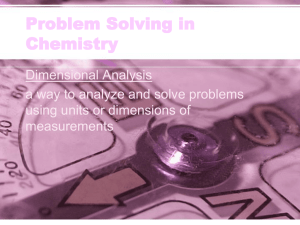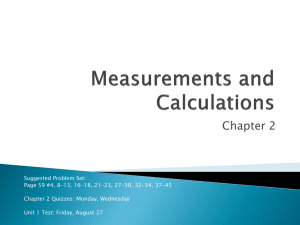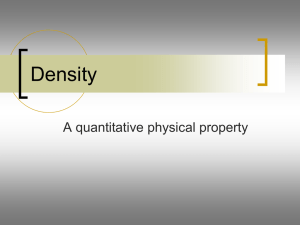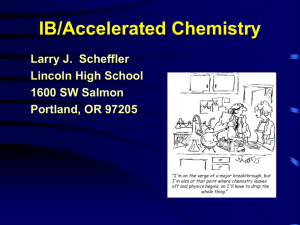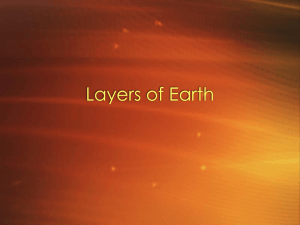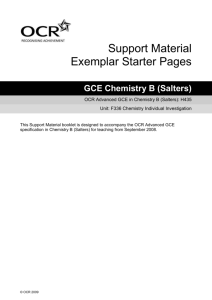Chapter 01 - Yale Chemistry
advertisement
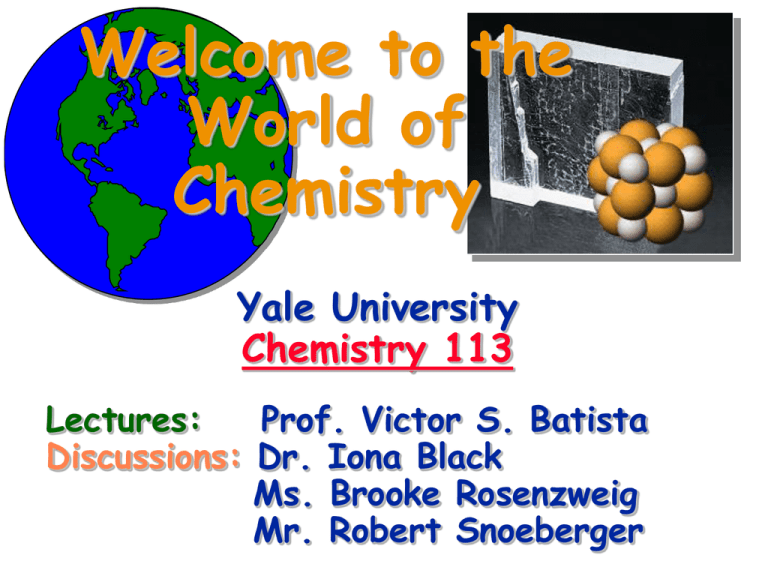
Welcome to the World of Chemistry Yale University Chemistry 113 Lectures: Prof. Victor S. Batista Discussions: Dr. Iona Black Ms. Brooke Rosenzweig Mr. Robert Snoeberger REGISTRATION Chem 113 students have to register their preferences for a discussion section online as well as in the hard copy card distributed during the first lecture. Students will be able to register their section or lab preference (1, 2, 3) online by following instructions at the Online Course Information (OCI) website. Preference selection has opened and will close on Friday, Sept. 7 at 12:30 PM. At that time each instructor will be able to assign students according to their preferences for sections. The office staff will upload the section assignments to the Online Course System (OCS) and students will be able to see their section on their course registration sheet. Where’s the Syllabus ? https://classesv2.yale.edu/portal/ What does Chemistry concern with ? Chemistry is the foundation of all molecular sciences Chemistry provides understanding, prediction and control of the nature and behavior of matter Chemistry is practical and profoundly philosophical HOW CAN SUBSTANCES BE MADE ? HOW DOES MATTER REACT ?! WHAT MATTER IS ?!! Chemistry & Matter • Chemistry explores the MACROSCOPIC world — what we can see — • to understand the PARTICULATE world we cannot see. EXPERIMENTS provide insights into these worlds beyond what our eyes can actually see!! Chem 113 students are strongly encourage to take the lab Chem 116L Chemistry 116L Fall 2007 Register in Chem 116L online through the OCS Placement list will be available online on September 7. Purchase a copy of the lab manual from TYCO (corner of Elm & Broadway), and study the first ten pages. Next week we have orientation and Ex. 1. at 1 pm (for both the 12 noon and 1 pm sections). Everyone should try to attend the orientation on the day they are placed in Chemistry 116L. Wear shoes ! Any questions? Need additional info? Email Dr. G: narasimhan.ganapathi@yale.edu A Chemist’s View: Exp. I Macroscopic Particulate Symbolic 2 H2(g) + O2 (g) --> 2 H2O(g) Chemical Properties and Chemical Change •Burning hydrogen (H2) in oxygen (O2) gives H2O. • Chemical change or chemical reaction — transformation of one or more atoms or molecules into one or more different molecules. Scientific Method • (1) OBSERVE AND QUESTION about some aspect of the world. • (2) POSTULATE a tentative explanation (HYPOTHESIS) and make predictions. • (3) TEST those predictions against observations of reproducible events. • (4) REPEAT steps 2 and 3 until there are no more discrepancies between predictions and observations. When consistency is obtained, hypotheses become a theory (i.e., a coherent set of propositions that explain a wide class of phenomena. Types of Observations and Measurements • We make QUALITATIVE observations of reactions — changes in color and physical state. • We also make QUANTITATIVE MEASUREMENTS, which involve numbers. • Use SI units — based on the metric system UNITS OF MEASUREMENT Use SI units — based on the metric system Length Meter, m Mass Kilogram, kg Time Seconds, s Temperature Celsius degrees, ˚C kelvins, K Units of Length • 1 kilometer (km) = ? meters (m) • 1 meter (m) = ? centimeters (cm) • 1 centimeter (cm) = ? millimeter (mm) • 1 nanometer (nm) = 1.0 x 10-9 meter o • 1 angstrom (A) = 1.0 x 10-10 meter O—H distance = 9.4 x 10-11 m 9.4 x 10-9 cm 0.094 nm o 0.940 A Temperature Scales • Fahrenheit • Celsius • Kelvin Anders Celsius 1701-1744 Lord Kelvin (William Thomson) 1824-1907 Temperature Scales Fahrenheit Boiling point 212 ˚F of water Celsius Kelvin 100 ˚C 373 K 100 K 180˚F Freezing point of water 100˚C 32˚F 0˚C 273 K Notice that 1 K degree = 1 degree Celsius Temperature Scales 100 oF = 38 oC = 311 K 32 oF = 0 oC = 273 K oF oC K Conversion Factor: 100 oC degrees per 180 oF degrees 38 oC = (100 oF – 32 oF) * 100 oC / 180 oF 311 K = 273 K + 38 oC * 100 K / 100 oC Calculations Using Temperature • Generally require temp’s in kelvins • T (K) = t (˚C) + 273.15 • Body temp = 37 ˚C + 273 = 310 K • Liquid nitrogen = -196 ˚C + 273 = 77 K Physical Properties What are some physical properties? • color • melting and boiling point • odor sodium Physical properties salt characterize the identity of pure substances Physical Changes Some physical changes would be • boiling of a liquid • melting of a solid • dissolving a solid in a liquid to give a homogeneous mixture — a SOLUTION. Physical changes do not change the identity of Pure Substances Physical properties, cont’d DENSITY - an important and useful physical property Density Mercury mass (g) volume (cm3) Platinum Aluminum 13.6 g/cm3 21.5 g/cm3 2.7 g/cm3 Problem A piece of copper has a mass of 57.54 g. It is 9.36 cm long, 7.23 cm wide, and 0.95 mm thick. Calculate density (g/cm3). Density mass (g) volume (cm3) Strategy 1. Get dimensions in common units. 2. Calculate volume in cubic centimeters. 3. Calculate the density. SOLUTION Conversion factor 1. Get dimensions in common units. 1cm 0.95 mm • = 0.095 cm 10 mm 2. Calculate volume in cubic centimeters. (9.36 cm)(7.23 cm)(0.095 cm) = 6.4 cm3 Note only 2 significant figures in the answer! 3. Calculate the density. 57.54 g = 9.0 g/ cm3 6.4 cm3 Significant Figures ??!!! # of digits, starting from the left, with the first digit different from zero. (‘Trailing’ zeros don’t count) Significant Figures 57.54 g 7.23 cm 0.95 mm 0.095 cm 4 significant figures 3 significant figures 2 significant figures 2 significant figures (zeros to the left of 9 simply locate the decimal point) 600. g 3 significant figure 8000 kg 1 significant figure 100 cm/m infinte number of significant figures (defined quantity) INVERSE PROBLEM: Mercury (Hg) has a density of 13.6 g/cm3. What is the mass of 95 mL of Hg in grams? In pounds? Solve the problem using DIMENSIONAL ANALYSIS. PROBLEM: Mercury (Hg) has a density of 13.6 g/cm3. What is the mass of 95 mL of Hg? First, note that 1 cm3 = 1 mL Strategy 1. Use density to calc. mass (g) from volume. 2. Convert mass (g) to mass (lb) Need to know conversion factor = 454 g / 1 lb Inverse Problems PROBLEM: Mercury (Hg) has a density of 13.6 g/cm3. What is the mass of 95 mL of Hg? 1. Convert volume to mass 13.6 g 3 95 cm • = 1.3 x 103 g cm3 2. Convert mass (g) to mass (lb) 1.3 x 103 g • 1 lb = 2.8 lb 454 g

